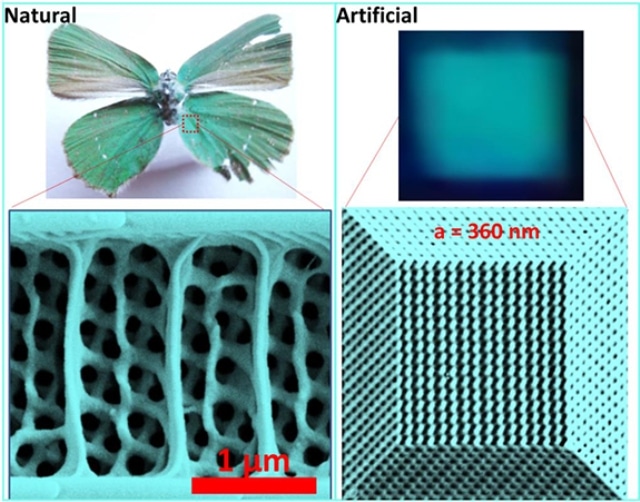Jun 2 2016
Swinburne researchers have devised a technique based on the complex structure of a butterfly wing that could be leveraged to create amazing computer screens.
 Comparison of natural gyroid structure with artificial structure. (© Swinburne)
Comparison of natural gyroid structure with artificial structure. (© Swinburne)
Using a special printing technique, the scientists created minute structures similar to that found in the wings of the Callophrys Rubi butterfly, commonly known as the Green Hairstreak.
The wing of the Green Hairstreak contains an intertwining and curved surface pattern. This pattern is referred to as gyroid structure that displays interesting properties while interacting with light.
A dual beam light was used by the team to print at a high resolution and to ultimately produce gyroid structures that are mechanically strong and three-dimensional.
Dr Zongsong Gan, lead author, Swinburne’s Centre for Micro-Photonics stated that the materials produced from the artificial gyroids would be suitable for high-speed switches as they would rapidly respond to light.
Dr. Gan explains that this technique provides two major benefits.
The first is that it has improved resolution and the second is that the materials fabricated with this technique have better mechanical strength. These new gyroid structures could help make more compact light based electronics because, thanks to their smaller size, larger numbers of devices can be integrated onto a single chip. However, for three-dimensional devices, smaller and more compact also means there is a higher risk of structure collapse because of weaker mechanical strength. Our fabrication technique allows us to make stronger architectures to overcome this problem.
Dr Zongsong Gan, Swinburne's Centre for Micro-Photonics
The Australian Research Council Centre for Ultrahigh-bandwidth Devices for Optical Systems, the Laureate Fellowship scheme, and the Science and Industry Endowment Fund under the John Stocker Postdoctoral Fellowship supported this research.
The study results were reported in the Science Advances journal.